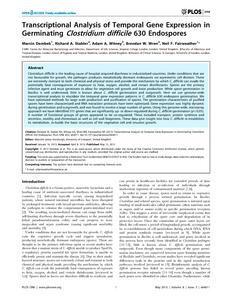Dembek, M; Stabler, RA; Witney, AA; Wren, BW; Fairweather, NF
(2013)
Transcriptional analysis of temporal gene expression in germinating Clostridium difficile 630 endospores.
PLOS ONE, 8 (5).
e64011.
ISSN 1932-6203
https://doi.org/10.1371/journal.pone.0064011
SGUL Authors: Witney, Adam Austin
![[img]](https://openaccess.sgul.ac.uk/101323/1.hassmallThumbnailVersion/pone.0064011.pdf)  Preview |
|
["document_typename_application/pdf; charset=binary" not defined]
Published Version
Download (5MB)
| Preview
|
Abstract
Clostridium difficile is the leading cause of hospital acquired diarrhoea in industrialised countries. Under conditions that are not favourable for growth, the pathogen produces metabolically dormant endospores via asymmetric cell division. These are extremely resistant to both chemical and physical stress and provide the mechanism by which C. difficile can evade the potentially fatal consequences of exposure to heat, oxygen, alcohol, and certain disinfectants. Spores are the primary infective agent and must germinate to allow for vegetative cell growth and toxin production. While spore germination in Bacillus is well understood, little is known about C. difficile germination and outgrowth. Here we use genome-wide transcriptional analysis to elucidate the temporal gene expression patterns in C. difficile 630 endospore germination. We have optimized methods for large scale production and purification of spores. The germination characteristics of purified spores have been characterized and RNA extraction protocols have been optimized. Gene expression was highly dynamic during germination and outgrowth, and was found to involve a large number of genes. Using this genome-wide, microarray approach we have identified 511 genes that are significantly up- or down-regulated during C. difficile germination (p≤0.01). A number of functional groups of genes appeared to be co-regulated. These included transport, protein synthesis and secretion, motility and chemotaxis as well as cell wall biogenesis. These data give insight into how C. difficile re-establishes its metabolism, re-builds the basic structures of the vegetative cell and resumes growth.
Statistics
Item downloaded times since 04 Jul 2013.
Actions (login required)
 |
Edit Item |




